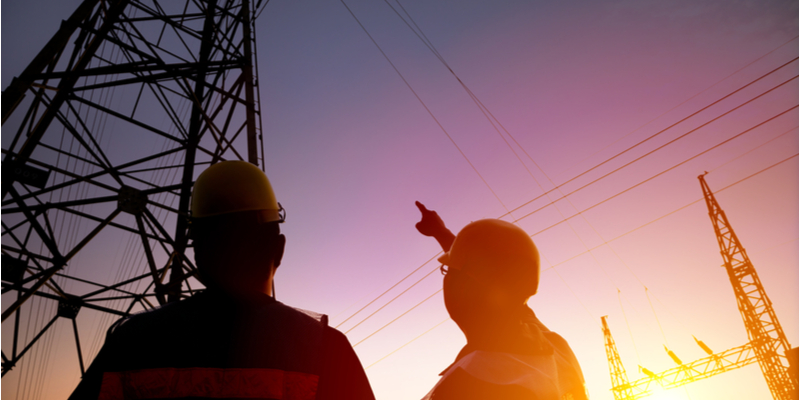The cost-effective solution to utilities and energy security issues
- Security for businesses
- FILTER_Security for businesses

Energy and utilities companies are part of national critical infrastructure, and as such require the highest possible degree of security - but this is not without its challenges. We asked Tara Biglari (Sales Director, Americas) to share her thoughts on the physical security needs of critical infrastructure businesses, and how video analytics like Calipsa can help.
In the physical security industry, we often talk about securing energy and utilities “facilities”, but it doesn’t really convey all the different sites that fall under this term. So what do we mean when we talk about facilities? They could include:
- corporate offices
- gas pipelines
- metering and regulating facilities
- liquid natural gas plants
- generating plants
- electric substations
- electrified yards
- services stations
...and more.
Each type of site has its own security risks, depending on how it operates and what is stored there. A lot of these sites will be remote and in locations where it’s not feasible to have a guard on site 24/7. On the other hand, sites like service stations have a lot of traffic coming in and out: gas technicians and gas engineering teams, mechanics to fix vehicles, and often just as a central point where everybody is dispatched from. These sites can be hard to secure for the opposite reason - there are simply too many busy entry and exit points.
Utilities companies face the same physical security threats as any business - intruders, theft and criminal damage - but as part of national critical infrastructure, there are the added pressures of terrorism and politically-motivated attacks. With such high stakes, a security incident could be extremely costly, for the utilities company and also for the many businesses, public services and homes who rely on them for power.
When you combine heightened threat levels with multiple remote sites, which each have different vulnerabilities, you have some very complex security requirements. So how do we go about simplifying them? One of the easiest and most cost-effective ways is remote video surveillance, monitored by a command center / security operations center (SOC).
We have even more articles, advice and downloads for your industry in our dedicated Utilities Resource Hub:
Video surveillance for energy and utilities
In situations where a site is remote, such as substations, it is far more cost-effective and scalable to have security cameras alerting into a SOC where an operator can monitor the video. This is especially the case for energy companies with hundreds of remote substations under their purview.
Remote video monitoring systems send alerts to security teams in real time, enabling them to respond swiftly and address threats as and when they occur. Most often, the main goal is to detect intruders coming onto facilities with nefarious intentions - one of which is equipment theft. Losing valuable equipment like a generator can deal a huge financial blow to energy companies, so investing in systems that reduce the likelihood of this happening proves its worth very quickly.
The great thing about remote monitoring is that you can supplement it with security guards in a more targeted way. For example, at extra critical facilities, you can have security staff on site, but security cameras provide additional information about events such as a vehicle approaching - remote monitoring staff can inform staff on-site which allows them to make a judgment call on what action to take.
Many energy companies I’ve talked to have physical security teams in-house who manage the overall strategy, but they will outsource some manned guarding to security companies for their critical locations.
Enhance remote security with video analytics
Most energy companies have some type of proactive monitoring in place, especially in their most critical or high-risk locations. This is a great start for an industry that can be risk-averse when it comes to taking on new technologies. Whether it’s live monitoring or event-based monitoring, in most cases there is some element of video-based security. For those businesses who haven’t adopted it yet, there is definite interest in employing it in future, for its flexibility and cost-effectiveness.
A trend I’ve noticed when speaking with energy companies is the growing interest in event-based monitoring. Unlike live monitoring, where an operator watches video feeds to detect an incident, event-based monitoring uses intelligent video analytics to optimise this process. With analytics doing the legwork, operators are more focused and better able to react quickly to automated alerts. Along with the more obvious benefits that this brings - improved efficiency and employee morale, a lower rate of missed incidents - intelligent video analytics can help in other ways too.
The success of a video surveillance system really depends on how you use your video. Most people seem to agree that a camera will tell you how and when an event happened, but the success rate at deterring a criminal with cameras alone is minimal. Thieves know that if they conceal themselves (e.g. by wearing a hoodie) then there is a chance they won’t be caught. What’s more, authorities can use video in an investigation, but using that same footage in court is often limited or not possible at all.
However, if you have a well-manned SOC which receives an instant intruder alert via video analytics, you can put a voice over IP to speak to the intruder, informing them they have been seen. This is much more likely to work at deterring a criminal because you are using your video as real-time intelligence. In essence, having cameras isn’t all that useful unless you’re using them to actively deter crime in real time. To do this well, intelligent video analytics is an essential tool.
Improve operations with video analytics
In utilities and energy facilities, security is often tied on a daily basis with operations, and they collaborate internally with other teams to make sure work gets done. For this reason it doesn’t make sense to think of security as something separate from your other business functions - it benefits every department to take a more connected approach.
If you work on improving your security systems, you’ll also be equipped with tools that can help you improve operations, health and safety, and much more. In-house security teams already perform risk analysis, try to visit all the facilities and work as closely as possible with operations and health and safety teams; together, they ensure an approach that meets security goals with other department considerations in mind.
By enhancing this approach with intelligent video analytics, every department can benefit from the proactive video intelligence that alerts provide. For example, if slips and falls are a particularly bad issue in one generating plant, using cameras that can send alerts every time a slip and/or fall is detected can help health and safety teams gain a better understanding of the root cause. With the benefit of this knowledge they can work much quicker and more effectively at fixing the issue.
Almost everyone I’ve spoken to in this space agrees that event-driven video monitoring is an innovative and cost-effective way of protecting critical infrastructure facilities and assets. If an intelligent analytics tool like Calipsa can help them do it more efficiently (while staying compliant with regulations) then the utilities and energy sector will reap the rewards of adopting this cutting-edge technology.
Discover even more Utilities & Energy security content in our dedicated Resource Hub:








No comments